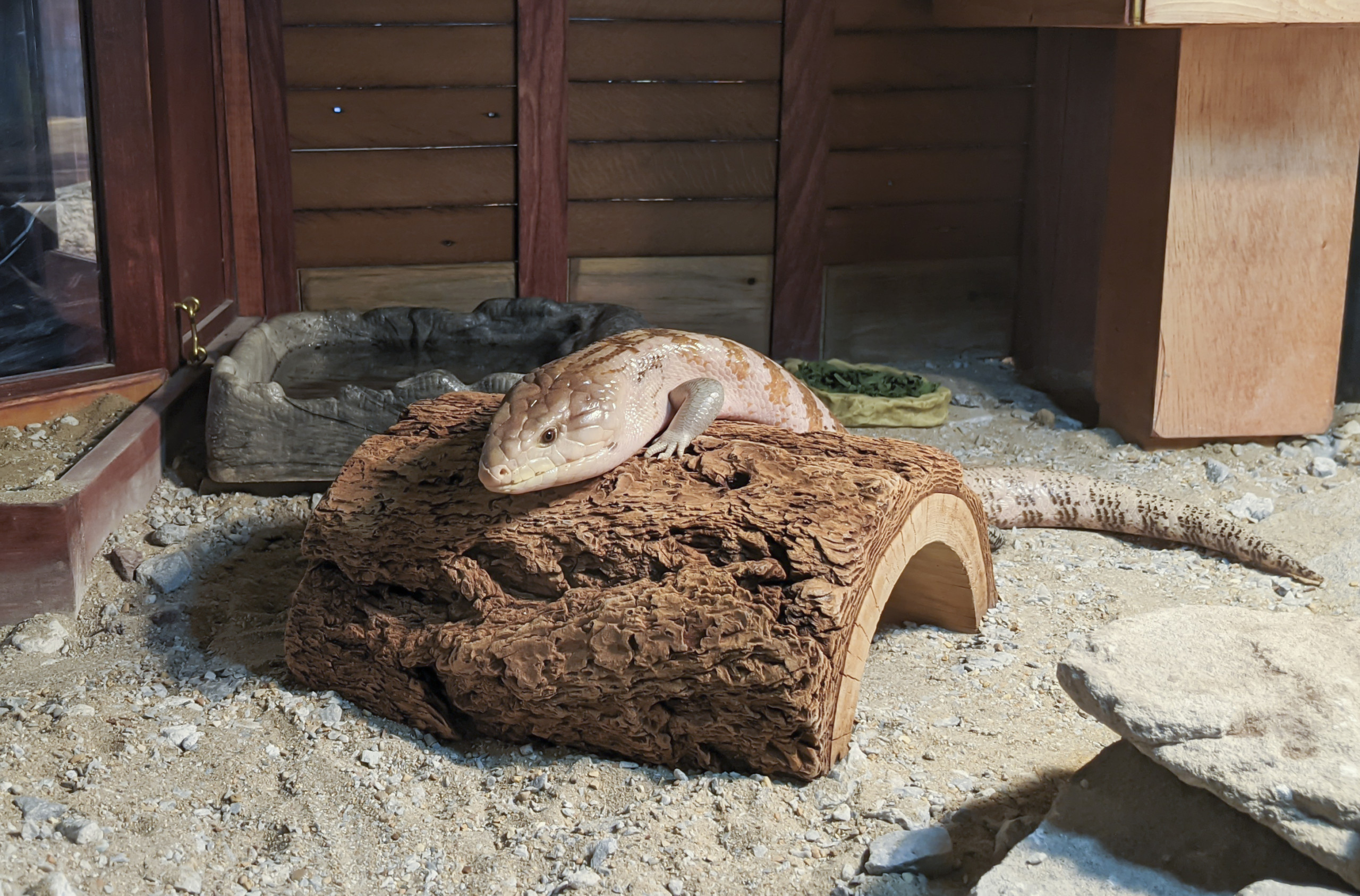
Mooch, one of the WonderLab Blue-tongued skinks. Photo by WonderLab Staff.
What is a Blue-Tongued Skink?
At first glance, you might mistake a blue-tongued skink for a snake. Blue-tongued skinks burrow and hide just like snakes. You might only be able to see the skink’s head and elongated neck as it peeks out from its hiding place. It moves along the ground on its belly, propelled by its stubby legs, which might make it appear to be slithering.
Do not be fooled!
Blue-tongued skinks are lizards. Specifically, they are lizards in the family Scincidae. “Skink” is the common name of lizards that make up this family, and they are characterized by their smooth, shiny bodies and short legs. This is the most diverse family of lizards, with over 1200 known species, about a 1/4 of the world’s population of lizards.
Where Do Skinks Live?
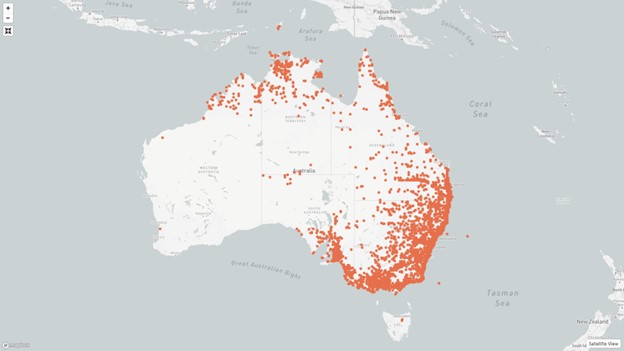
Map showing the distribution of blue-tongued skinks on the eastern and northern coasts of Australia, the western side of Papua New Guinea, and the island of Tasmania that is located south of Australia Attribution: Australian Museum, Mapbox
Blue-tongued skinks are native to Australia, New Guinea, and Tasmania where they live in grasslands, forests, rainforests, and deserts. In Australia, they are sometimes given the nickname of “blue-tongues” or simply just “blueys.”
Invasive Species or Exotic Pet?
These reptiles are also popular in the pet trade. Unfortunately, skinks are often released in regions where they are non-indigenous. According to National Geographic, “… even intentional releases of exotic pets—are not uncommon… If the animal doesn’t die as a result of predation, exposure, or starvation, it may find a mate, proliferate, and become an invasive species. The exotic pet trade now ranks among the primary causes of the spread of invasive species, according to a new academic review published last month (June 2019) in the journal Frontiers in Ecology and the Environment” (Roth, 2019).
Mooch and Norbert
WonderLab’s blue-tongued skinks were both donated, and now live in a new exhibit space. This exhibit highlights the interconnectedness of the environment, the evolution of those living in it, and how climate change can affect this trajectory. The Hidden Life of Deserts exhibit is a year-round destination where children and families can meet a variety of live animals face-to-face, and learn about those animals’ essential environments and how to protect them.
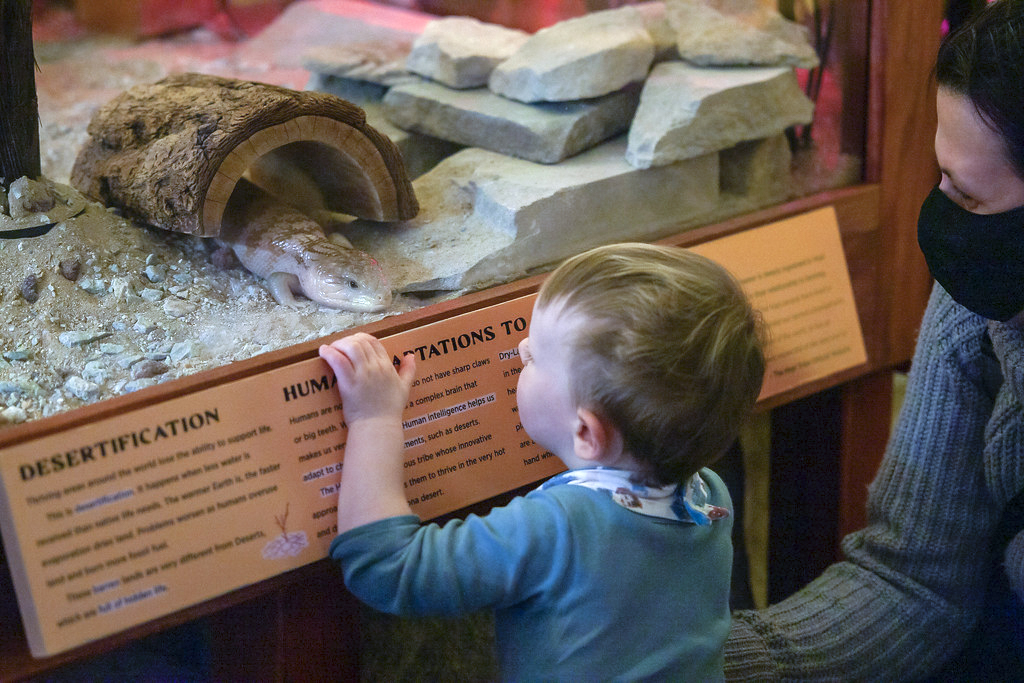
A young visitor at Hidden Lives of Deserts. Photo by Andrea Golden.
Mooch is a cross between two types of skinks that originate in Indonesia and Australia. A family gave Mooch to the Museum in 2013. They like to keep in touch and visit him whenever they’re in town. Mooch is enjoying his new digs. You can often find him basking on a warm, sunny rock.
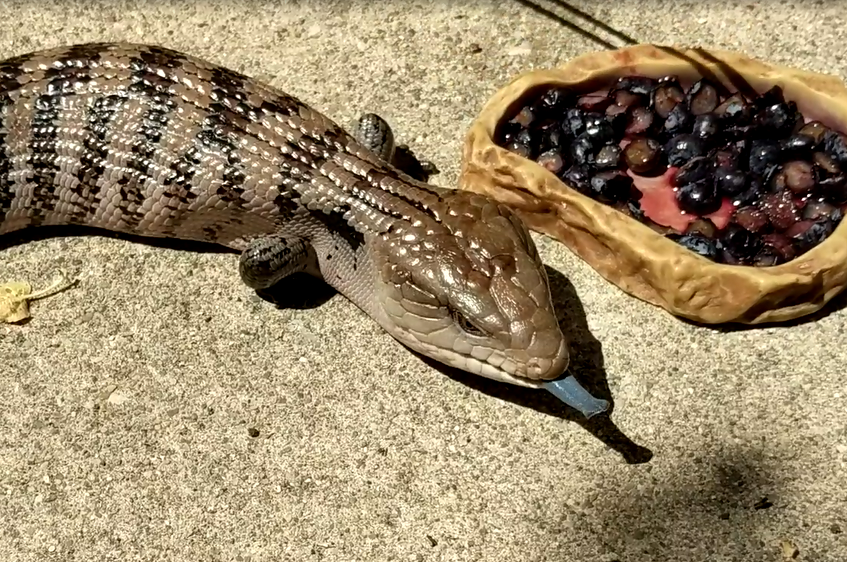
Norbert eating blueberries. Photo by WonderLab staff.
Norbert is an Eastern Blue-Tongued Skink who came to WonderLab in 2020 when his owner moved across the country. He was a master tunnel-maker when he arrived, but wasn’t much of a hunter. Blue-tongued skinks are omnivores. Their diets include insects, snails, flowers, fruits, and berries, so in the wild they need to be able to hunt live prey.
Supper Time!
Both Mooch and Norbert were raised in captivity and never hunted until moving to WonderLab. Blue-tongued skinks use their tongues to sense their slow-moving prey. When they started out, they were quite bad at hunting. They made mistakes sometimes biting their own tails and feet.
Norbert now hunts like a champ!
Along with prey, the skinks receive a diverse diet of greens, squash, zucchini, sweet potato, bell pepper, corn, carrots, cockroaches, mealworms, dog food, and (Mooch’s all-time favorite) blueberries. This diet mimics the omnivorous diet consisting of both plants and insects that the skinks would have in the wild.
Blue-Tongued Skinks as Animal Ambassadors
Mooch and Norbert are calm and tolerant of being handled, so they are excellent Animal Ambassadors. Animal Ambassadors help WonderLab’s staff teach visitors about animal physiology, habitats, and behaviors. Visitors meet them in the museum, and they sometimes even travel for special appearances.
Mooch recently represented his species on local television in a program that introduces the new Hidden Life of Desert exhibit. You can see Mooch’s television debut here.
Skinks Play Hide and Seek!
The blue-tongued skinks’ exhibit provides enrichment opportunities for the skinks to practice their natural behaviors. There is a dig box where the skinks can dig and burrow. A light station provides both heat and light for basking. The lights turn on and off at different times during the day mimicking how the sun moves across the sky. This encourages the skinks to move around seeking a warm, sunny basking spot.
You might occasionally have a hard time spotting the blue-tongued skink in its enclosure. This is because they are burrowing animals with few defenses. They like to hide in the substrate and underneath logs and brush.
Tongues are for More than Tasting
Mooch loves blueberries. But is that why his tongue is blue? Nope! Skinks’ blue-tongues are an adaptation that has evolved to ward off predators. The color blue is associated with being poisonous in the animal world. Predators often pass over animals that display the color blue.
A skink will stick out and flatten its tongue if attacked or threatened. A skink’s tongue actually has a hidden power that humans cannot see: reflection! According to researchers from Macquarie University, Australia, “The back of the (skink’s blue) tongue reflected twice as much light and more UV than the midsection while the tip was the dullest.”
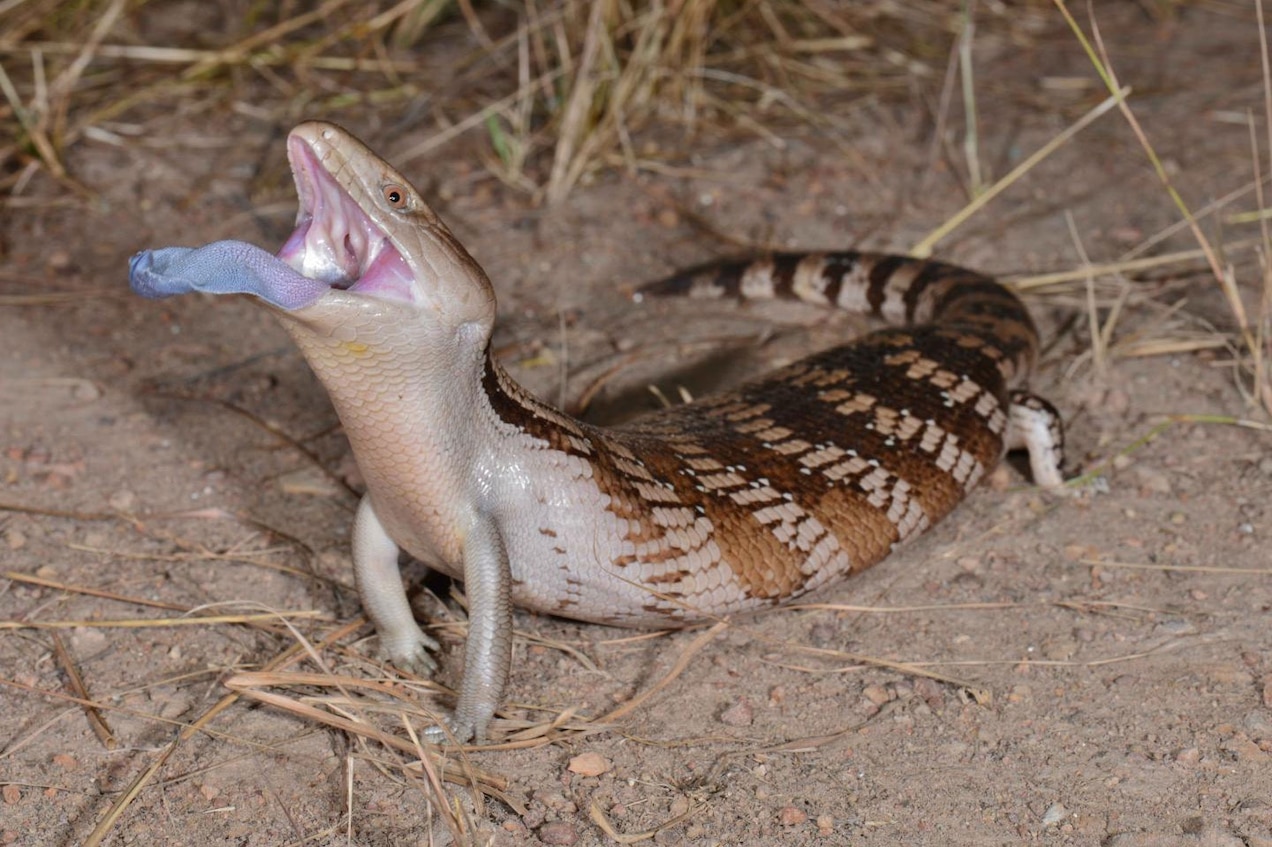
A blue-tongued skink sticks out its tongue in a defensive position. Photo by National Geographic / Shane Black. Used with permission.
Adaptations
Humans may not be able to see ultraviolet light, but a skink’s common predators such as birds, monitor lizards, and snakes can see it. When the skink flashes its tongue, enemies are surprised and distracted. This might cause them to pause giving the skink a chance to escape.
A skink’s large, smooth scales also provide protection. The scales have a glassy appearance and are supported by bony plates called osteoderms. The scales are very strong and provide an extra layer of protection like a suit of body armor.
Visit the WonderLab Skinks
Visitors can meet Mooch and Norbert in the Museum, where WonderLab Animal Care staff are available to answer questions. Mooch also helps with WonderLab’s Animal Adaptations program. This program, available to classes and groups, showcases specific lessons about lizards and vertebrates.

Sources
Blue tongued skink. Lehigh Valley Zoo. Retrieved March 21, 2022, from https://www.lvzoo.org/animals/blue-tongued-skink/#:~:text=Blue%2DTongued%20Skinks%20live%20in,predators%20and%20the%20scorching%20heat
Eastern blue-tongue lizard. The Australian Museum. (2020, November 19). Retrieved March 21, 2022, from https://australian.museum/learn/animals/reptiles/eastern-blue-tongue-lizard/
Lenin, J. (2018, June 18). Why do blue-tongued skinks have blue tongues? The Wire. Retrieved March 21, 2022, from https://thewire.in/environment/blue-tongued-skinks
NASA. (n.d.). Ultraviolet waves. NASA. Retrieved May 18, 2022, from https://science.nasa.gov/ems/10_ultravioletwaves
Roth, A. (2021, May 4). Why you should never release exotic pets into the wild. Animals. Retrieved May 6, 2022, from https://www.nationalgeographic.com/animals/article/exotic-pets-become-invasive-species
Stratton, M. (2021, December 14). WonderLab debuts new exhibit hidden life of deserts. WISHTV8. Retrieved May 6, 2022, from https://www.wishtv.com/lifestylelive/wonderlab-debuts-new-exhibit-hidden-life-of-deserts/
Zachos, E. (2018, June 8). This Lizard Has a Blue, Ultraviolet Tongue—Here’s Why. Animals. Retrieved March 21, 2022, from https://www.nationalgeographic.com/animals/article/northern-bluetongue-skink-ultraviolet-tongue-animals

Leave A Comment